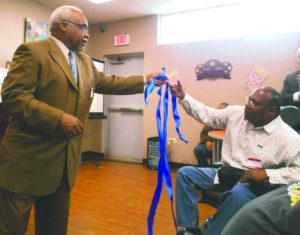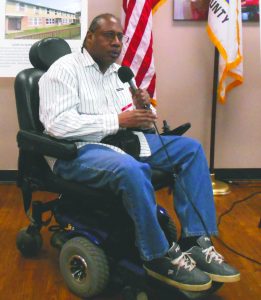Cook County rehabbing 1,255 public housing units throughout suburbs
By Igor Studenkov For Chronicle Media — February 19, 2019
Officials (from left) Cook County Commissioner Deborah Sims (D-5th), Cook County Board President Toni Preckwinkle, Illinois Housing Development Authority Executive Director Audra Hamernik and Village of Robbins Mayor Tyrone Ward cut the ribbon to symbolically mark the completion of renovations of Richard Flowers Homes and Edward Brown Apartments public housing developments. (Photo by Igor Studenkov/for Chronicle Media)
Kathy Harris got choked up several times as she thanked Housing Authority of Cook County for the great job they did rehabbing Turlington Apartments, the Harvey public housing development where she lives.
“I’m so thankful and grateful,” she said. “They took a shabby building, and rebuilt it. And they made sure that our safety is the most important.”
This was part of an ongoing effort to rehabilitate 11 HACC public housing developments throughout the southern, northwestern and northern suburbs. Aside from general maintenance and refurbishments, the project put emphasis on making units more friendly for seniors and people with disabilities. The project was made possible thanks to the federal Rental Assistance Demonstration program, which allowed HACC to borrow money it otherwise wouldn’t have been able to in order to cover $200 million in project costs.
For the most part, the renovations have already been completed. The construction crews are putting finishing touches on the few developments, and at least one development still needs to be rehabilitated. HACC is currently expecting to wrap up the last phase of the project by late 2019.
As previously reported by the Chronicle, HACC handles affordable housing in Cook County suburbs that don’t have housing authorities of their own. It operates public housing developments geared toward families, as well as developments geared toward seniors and/or people with disabilities. It also manages federally funded Housing Choice “Section 8” vouchers, which help residents cover rent, provided that rent rate doesn’t go above a certain amount.
Over the past 20 years, Chicago Housing Authority and many other housing authorities throughout United States demolished public-housing developments geared toward families. In Chicago’s case, many of those developments either have already been replaced or are in the process of being replaced with mixed-income developments where only some of the units are reserved for public housing residents. With senior public housing, on the other hand, CHA tended to either keep the developments as it is or extensively renovate them.
HACC currently has a total of 19 developments and two “scattered housing” clusters where the units aren’t located in one building or a group of buildings. Out of the 19 developments, five are geared toward families, while the remaining 14 are geared toward either seniors, people with disabilities or both. The renovation projects involved Richard Flowers Homes, a family development in Robbins, and 10 senior and/or disability-friendly developments located in Arlington Heights, Chicago Heights, Des Plaines, Evanston, Franklin Park, Harvey, Niles, Skokie, Robbins, Park Forest and Wheeling.

: Village of Robbins Mayor Tyrone Ward (left) hands the cut ribbon to Sidney Threadwell, a resident of Village of Robbins’ Edward Brown Apartments. (Photo by Igor Studenkov/for Chronicle Media)
Richard Monocchio, HACC’s executive director, said his agency decided to renovate the developments rather than demolish them for two reasons — renovating them would simply be cheaper and the buildings were fundamentally physically sound.
“These are solidly built buildings, so they didn’t need to be demolished,” he said. “They just suffered from deferred maintenance, so it made sense to build on what’s already there.”
HACC spokesperson Nicholas Mathlowdis noted that preserving the units was especially important given that a growing number public housing residents is moving to the suburbs and many seniors are struggling to be able to stay in their communities.
The project kicked off in 2012. HACC has completed the majority of renovations. The one major piece that needs to be completed is the rehabilitation of the two-building Golden Towers, a Chicago Heights senior housing development, which is expected to be completed later this year.
“Right now, we are rehabilitating another 275 units as we speak, and we’re going to begin rehabilitating 116 in a couple of months,” Monocchio said.
According to the handout provided by HACC, the exact nature of the rehabilitations varied. All buildings had their apartments refurbished, with new paint, flooring, fixtures and utilities, and the exteriors were spruced up as well. In many cases, a few units were renovated to be more accessible, and several units were renovated to better fit the needs of residents with visual or hearing disabilities. Even for Richard Flowers Homes, which isn’t specifically geared toward seniors and people with disabilities, the agency wanted to make the units more acceptable. Two units became “visual/hearing impaired” units. And whereas before, the buildings had 17 two-story townhouse-style apartments, with a kitchen on the lower floors and bedrooms on the upper floors, the buildings were renovated so that each apartment occupied a single floor. The overall number of apartments remained the same, but in nine of those apartments, tenants no longer had to climb stairs, which made them more suitable for people with mobility issues.
Overall, the project cost $200 million. Monocchio explained that funding was made possible thanks to the federal Rental Assistance Demonstration program, which allowed HACC to “use [its] property as collateral to get loans from banks.”
“That provided a significant amount of financing,” he said. “Before, with public housing, you couldn’t do that.”
To mark the milestone, HACC held a press conference at Richard Flowers Homes’ community center. In his opening remarks, Monocchio emphasized that the rehabilitation project improved “the quality of life for some of our most vulnerable residents in this county.

Richard Flowers Homes, a family public housing development that got renovated as part of HACC rehab of most of its public housing developments. (Photo by Igor Studenkov/for Chronicle Media)
Cook County Board President Toni Preckwinkle said that she was proud that HACC was able to pull of the rehabilitation, especially amidst diminishing state and federal funding.
“We’re especially proud of [improvements] in the south suburbs, where the need for affordable housing is growing daily,” she said.
County Commissioner Deborah Sims (D-5th) said that it was important for seniors to be able to stay in their communities, if they want to, especially if they struggle to afford to keep the roof over their heads.
“We need to provide [housing] for the less-fortunate people,” she said. “We see more and more veterans without a place to live. I’ve seen seniors living on the streets.”
Sims also said she was grateful for the fact that HACC invested in housing in Robbins in particular, arguing that the village “deserves for the housing to be redeveloped” and arguing that investment in Robbins will pay off.
Residents from Richard Flowers Homes and other developments were invited to attend, and several of them — including Harris — spoke about their experiences.
Sidney Threadwell, who uses a wheelchair, lives in the nearby Edward Brown Apartments. He said he especially appreciated the accessibility improvements.

Sidney Threadwell, a resident at Edward Brown Apartments said HACC renovations made his building more accessible to him. (Photo by Igor Studenkov/for Chronicle Media)
“I like some of the improvements they’ve done to the building,” he said. “My unit especially, because of my disability, they made it accessible. I won’t move for nothing in the world.”
Natasha Richardson, who lives in Richard Flowers Homes with her daughter, who has a disability, echoed his praise.
“I have a handicapped child, and it’s like everything is made for her,” she said. “I’m just touched right now. It feels good to [invite someone over] and not feel ashamed about where we live at. I’m just happy, and I’m grateful for everyone who helped.”
Junior McReynolds was one of the several public housing residents who simply stopped by to watch. Born in Alabama, he spent most of his adult life in Chicago’s Woodlawn neighborhood. After his wife died, he went looking for an affordable housing option. When he was offered a unit in Edward Brown Apartments, he liked what he saw. McReynolds moved in a little more than two years ago, and he said he is glad he did.
“It’s been great,” he said. “People [living there], they’re not just neighbors, they’re family. It’s a great family experience, in a big building.”
McReynolds said that HACC started renovating his building a year ago, and he appreciated the improvements.
“They put in so much,” he said. “They made the building more beautiful. They built a parking lot, they built a new drive-through [at the building’s front door], new floor, new tables. It’s beautiful, brand-new. The apartments, they repainted, they did new cabinets, new countertops, waxed floors. The apartments are just beautiful now.”







